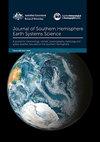East coast lows and extratropical transition of tropical cyclones, structures producing severe events and their comparison with mature tropical cyclones
IF 3.6
4区 地球科学
Q1 Earth and Planetary Sciences
引用次数: 0
Abstract
Examination of events occurring over the last 53 years in the Australian Region have revealed in the minds of forecasters a common pattern in the development of severe extratropical cyclones which have affected the sub-tropical and temperate East Coast. To evaluate this theory 20 years of data were systematically examined and showed that this was true. To represent these many cases nine such events which delivered the largest impacts over the 53 years were chosen for study. These extratropical cyclones formed downstream of a tropopause undulation which can be easily identified as a warm region at the 200 hPa-level and the formation zone was in a region of heavy rain embedded in a region of warm air advection at 700 hPa. There were hardly any exceptions to this general rule, and one that occurred is presented and was also one of the most rapidly developing systems. This pattern is then evaluated against tropical cyclone events which move in the Australasian sub tropics and three different scenarios are described and compared with a mature severe tropical cyclone which intensified as it moved into the Australia sub tropics. Hurricane Sandy due to its devastating effect on the US sub-tropics in 2012 is examined as a benchmark case whose impact could affect the Australasian sub tropics in the future as sea levels rise with higher density populations.东海岸低压和热带气旋的温带过渡、强事件的产生结构及其与成熟热带气旋的比较
对过去53年在澳大利亚地区发生的事件的研究,在预报员的脑海中揭示了影响亚热带和温带东海岸的强烈温带气旋发展的共同模式。为了评估这一理论,我们系统地检查了20年的数据,并表明这是正确的。为了代表这些案例,我们选择了53年来影响最大的9个此类事件进行研究。这些温带气旋形成于对流层顶波动的下游,在200 hPa水平上可以很容易地识别为暖区,形成区位于700 hPa暖空气平流区嵌入的大雨区。这条一般规则几乎没有任何例外,其中一个出现了,也是发展最快的系统之一。然后根据在澳大利亚亚热带移动的热带气旋事件对这种模式进行评估,并描述了三种不同的情景,并与进入澳大利亚亚热带的成熟强热带气旋进行了比较。由于2012年飓风桑迪对美国亚热带地区的破坏性影响,我们将其作为一个基准案例进行研究,随着海平面上升和人口密度的增加,它的影响可能会影响澳大利亚的亚热带地区。
本文章由计算机程序翻译,如有差异,请以英文原文为准。
求助全文
约1分钟内获得全文
求助全文
来源期刊

Journal of Southern Hemisphere Earth Systems Science
Earth and Planetary Sciences-Oceanography
CiteScore
8.10
自引率
8.30%
发文量
0
审稿时长
>12 weeks
期刊介绍:
The Journal of Southern Hemisphere Earth Systems Science (JSHESS) publishes broad areas of research with a distinct emphasis on the Southern Hemisphere. The scope of the Journal encompasses the study of the mean state, variability and change of the atmosphere, oceans, and land surface, including the cryosphere, from hemispheric to regional scales.
general circulation of the atmosphere and oceans,
climate change and variability ,
climate impacts,
climate modelling ,
past change in the climate system including palaeoclimate variability,
atmospheric dynamics,
synoptic meteorology,
mesoscale meteorology and severe weather,
tropical meteorology,
observation systems,
remote sensing of atmospheric, oceanic and land surface processes,
weather, climate and ocean prediction,
atmospheric and oceanic composition and chemistry,
physical oceanography,
air‐sea interactions,
coastal zone processes,
hydrology,
cryosphere‐atmosphere interactions,
land surface‐atmosphere interactions,
space weather, including impacts and mitigation on technology,
ionospheric, magnetospheric, auroral and space physics,
data assimilation applied to the above subject areas .
Authors are encouraged to contact the Editor for specific advice on whether the subject matter of a proposed submission is appropriate for the Journal of Southern Hemisphere Earth Systems Science.
 求助内容:
求助内容: 应助结果提醒方式:
应助结果提醒方式:


